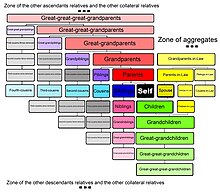Aunt

An aunt is relationship that describes a woman who is a sibling of a parent or is married to a sibling of a parent. Aunts are sometimes called Auntie or Aunty. A man is a nephew to their Aunt and a woman is a niece. An aunt is part of an extended family. The child of an aunt's is a cousin. Often the word aunt is used with people who are not related to show closeness or respect.
In many cultures there are different words to describe a person's mother's sister and father's sister. In Latin a mother's sister is matertera while a father's sister is amita.[1]
Detail
[change | change source]A maternal or paternal relative is one who is related through one's mother or father, respectively. For example, a maternal aunt is the subject's mother's sister. An in-law is a relationship that is not by blood, but instead by marriage. The in-law shares the in-law relationships of the spouse's relatives. For example, an aunt in-law could be the wife of the subject's uncle.
- aunt: parent's sister.
- maternal aunt: mother's sister.
- paternal aunt: father's sister.
- half-aunt: parent's half-sister.
- double-half-aunt: a person who is a half-sister of both of the subjects parents.[2]
- grandaunt (or great-aunt): grandparent's sister.
- great-grandaunt (or great-great-aunt): great-grandparent's sister.
- aunt-in-law: uncle/aunt's wife.
- aunt-in-law: spouse's aunt.
- co-aunt-in-law: spouse's uncle/aunt's wife.
- stepaunt: stepparent's sister.
- stepaunt: parent's stepsister.
References
[change | change source]- ↑ Constance Brittain Bouchard, Those of My Blood: Creating Noble Families in Medieval Francia (Philadelphia : University of Pennsylvania Press, 2001), p. 5.
- ↑ "GENETIC AND QUANTITATIVE ASPECTS OF GENEALOGY". Archived from the original on 2017-08-03. Retrieved 2020-07-06.